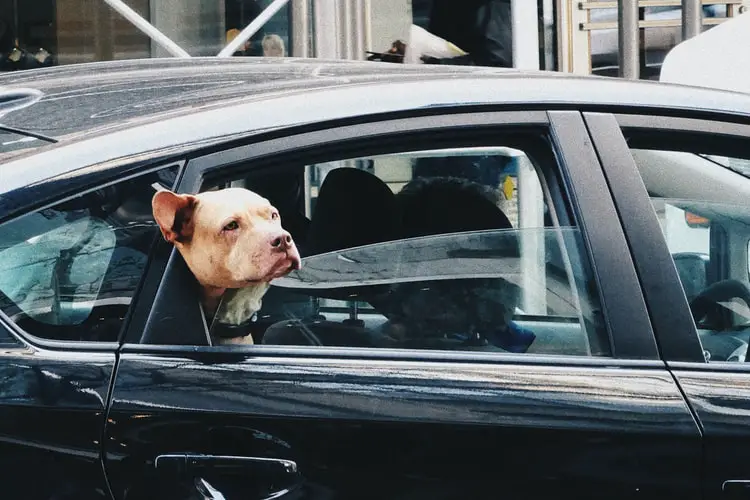Table of Contents
- How Does Benadryl Work?
- What Does Benadryl Treat in Dogs?
- When to Ask Your Vet About Benadryl for Dogs – Is It Safe to Give My Dog Benadryl for Anxiety?
- Is Benadryl Safe for Your Dog?
- HOW DO YOU CALM an ANXIOUS DOG? – Is It Safe to Give My Dog Benadryl for Anxiety?
- CAN I USE BENADRYL FOR GROOMING?
- Frequently Asked Questions – Is It Safe to Give My Dog Benadryl for Anxiety?
- What Are Some Alternatives to Benadryl for Dogs?
- Which Dogs Cannot Have Benadryl?
- Final Thoughts – Is It Safe to Give My Dog Benadryl for Anxiety?
The generic name of Benadryl is diphenhydramine. It is an OTC drug that vets recommend dog owners to use at home. Benadryl is effective, especially for anxious dogs. If your dog was stung by an insect and had a sudden mild allergic reaction, Benadryl is a good first aid. Benadryl is generally safe for dogs. However, it is not the answer to every health problem of your dog. Is it safe to give my dog Benadryl for anxiety? In some cases, other medications taken by your pet may have an adverse interaction with Benadryl. It is crucial to consult with a vet before giving Benadryl. Get informed what Benadryl can and cannot do for your pet. The following are some things to keep in mind before medicating your dog with Benadryl.
How Does Benadryl Work?

Is it safe to give my dog Benadryl for anxiety? Benadryl is an antagonist. Meaning the drug works by blocking the receptors that react to histamines in the body. Thus, it can eradicate many symptoms that can be traced to allergies, such as itching, sneezing, and hives. The body naturally produces histamines, but the receptor antagonist stops the receptors from processing the histamines. It is similar to the mailman trying to stuff more mail in a full mailbox. There simply is no room for it.
What Does Benadryl Treat in Dogs?
Is it safe to give my dog Benadryl for anxiety? Benadryl is extremely effective for many dog ailments, such as allergies and anxiety. When seasons change, dogs will have allergies that may come from food and the environment. They may also become allergic to insect bites. Many of these can be mitigated by Benadryl. Some allergic reactions that can be mitigated by Benadryl are the following:
- Itching
- Hives
- Swelling
- inflammation
- Redness
- Runny nose and eyes
- Coughing
- Sneezing
Keep in mind that Benadryl can cause drowsiness. Because of this, it helps calm extremely anxious dogs. Experts say that Benadryl relieves mild to moderate anxiety in dogs associated with traveling. It helps alleviate motion sickness during rides in planes and vehicles.
Is it safe to give my dog Benadryl for anxiety? Vets recommend Benadryl for dogs with mast cell tumors as well. It reduces the effect of large amounts of histamine released due to degranulation of the mast cells. Dosing with Benadryl is also an assistive cure for other health conditions. Vets recommend Benadryl during heartworm treatment. It prevents allergic reactions associated with the treatment therapy.
You must have Benadryl handy in your pet’s emergency kit. Consider putting one together today if you don’t have a pet emergency kit or pet travel kit yet.
When to Ask Your Vet About Benadryl for Dogs – Is It Safe to Give My Dog Benadryl for Anxiety?

Is it safe to give my dog Benadryl for anxiety? Before you get a bottle of Benadryl, consult with your vet about the symptoms of your dog. Allergic symptoms such as itching and watery eyes may be a sign of a more serious health condition. There are cases where conditions such as glaucoma might be worsened by dosing with Benadryl. Red eyes might be a symptom of allergies, but it can also be a symptom of glaucoma or dry eye. In this case, Benadryl doesn’t help. Itching might be a result of allergies or other skin conditions. It should be noted that Benadryl is not effective in treating certain skin diseases. It is a good move to consult with your vet to ensure that you are doing the proper steps for your dog’s health.
Your vet may recommend examining your dog. If you choose not to bring your dog to the vet clinic for an examination and if you administer Benadryl without consulting your vet, make sure to watch over your dog for adverse reactions and call your vet if their condition worsens.
Side Effects of Benadryl
There are several side effects of dosing Benadryl on dogs that every owner must be aware of. Similar to people, you should check with a doctor before applying a new medication. You should always consult with your vet before introducing Benadryl to your dog’s system. There might be adverse drug reactions with your dog’s other meds. It might even worsen an existing health issue.
If your dog suffers any of the following symptoms, only dose them with Benadryl after consulting with your vet:
- Glaucoma
- Heart failure
- Seizure
- Hypertension
- Allergic lung disease
- Pregnancy
Several side effects associated with dosing Benadryl for dogs are the following:
- Sedation
- Dry mouth
- Urinary retention
- Hypersalivation
- Increased heart rate
- Fast breathing
- Diarrhea
- Vomiting
- Poor appetite
Keep in mind that a majority of side effects will occur within the first hour of dosing. Monitor your dog carefully after giving them this medication.
Benadryl Overdose
It is possible that you might overdose your dog with Benadryl. Several signs of an overdose will include overexcitability of the nervous system. It can be fatal. Other warning signs to look for are the following:
- Fast heartbeat
- Dilated pupils
- Agitation
- Constipation
- Seizures
If your dog is exhibiting any of the symptoms and suspect that they had an overdose of Benadryl, get them to the vet at once.
Several dogs may have an allergic reaction to this medication. If your dog is showing symptoms of allergic reactions, get them to emergency vet care at once. Benadryl is often prescribed to alleviate allergies in dogs. Watch over your dog and observe their reactions to make sure the allergy symptoms don’t worsen.
Dosage of Benadryl for Dogs
The best way to know the correct dosage of Benadryl for dogs is to check with your vet. According to experts, dosing 2 to 4 mg of Benadryl per kilogram of your dog’s body weight 2 to 3 times a day is considered safe. However, this dosage can vary depending on the specific medical condition of your dog.
It is crucial never to utilize time-release capsules for dogs. Capsules are absorbed at a different rate compared to humans. It could affect the dosage for your dog. It is also possible that the capsule will break open once chewed and deliver too much medication at once. It can put your dog at risk of an overdose.
If you want to dose them with liquid Benadryl, you might want to opt for a children’s liquid formula. Most of these do not contain alcohol, although it does contain sodium. Benadryl pills or tablets designed for children can be used for very small breeds. Keep in mind that the dosage of liquid Benadryl is different than the pill form. Check with your vet for the ideal amounts of dosage. You might want to utilize a syringe to increase the dose’s accuracy and for an easier administration.
Benadryl will take up to 30 minutes to start showing its effects. Make sure to consider this when you treat your dog with nervousness or motion sickness. If dogs have chronic allergies that require daily doses, check with your vet about the ideal dosage since it could change over time.
When it comes to pregnant or nursing dogs, always check with your vet before giving Benadryl. In most cases, this drug is not recommended for dogs in this condition.
Is Benadryl Safe for Your Dog?
Overall, Benadryl is safe and effective for dogs. However, it would help if you used it according to the recommendations of your vet. Like any new medication, always watch over your dog after administration to ensure that they do not exhibit adverse symptoms. If you have doubts and questions about Benadryl, make sure to check with your vet for further information.
HOW DO YOU CALM an ANXIOUS DOG? – Is It Safe to Give My Dog Benadryl for Anxiety?
Some people utilize medicine to enhance their pet’s health. Benadryl is an effective medication in many cases.
No owner wants their dog to go through life, suffering anxiety and stress. If you have an overly anxious dog, you might have considered sedation before, but you aren’t sure of its safety. It is crucial to check with your vet to know how you can best help your furry friend in anxiety-provoking situations.
CAN I USE BENADRYL FOR GROOMING?
There are some cases where your dog might be extremely anxious with grooming. Benadryl will certainly help, but keep in mind that anxiety does not completely go away. If your dog is freaking out at the grooming salon, Benadryl is one option you can try. However, it is crucial to explore other options.
Some alternatives are the following:
Pretend to groom
Take small steps. Get your dog acquainted with a brush, soap, and water before the big day at the grooming salon. Try turning on the blow dryer. Pretend that you are clipping his nails. After this pretend grooming session, offer him a treat. This method may seem silly, but it will certainly help calm your dog.
Massage
Consider relaxing your dog with a massage. Your dog must get used to being touched not just on their head or back but also in other body parts. The more he gets used to being touched and exposed, the less frightening the grooming salon session will be.
Walk your dog
Take your dog for a walk prior to the appointment. It will help calm his nervous energies.
Trusted groomer
Choose a groomer you can trust and stick with them. Don’t go to a different grooming salon for every grooming session. It helps calm your dog if they are getting their grooming done in a place they are already comfortable with. If you move them around too much, it might make their anxiety worse.
Warning

It is crucial never to allow the groomer to dose your dog with Benadryl without consulting with a vet. If you are not sure about the outcome of anything, play it safe.
You might also want to utilize Benadryl to mitigate the stress associated with the following:
- Car rides
- Train rides
- Thunderstorms
- Allergies
- Separation anxiety
Frequently Asked Questions – Is It Safe to Give My Dog Benadryl for Anxiety?
How do I dose my dog with Benadryl?
Always give your pet the ideal amount of Benadryl dosage. One way to administer Benadryl is through their food. Benadryl in pill form can be wrapped in a slice of cheese or broken up with cooked meat pieces. What are the snacks your dog loves the most? You can start from there. Always make sure that the food you will be using with a Benadryl is fine for dogs to eat. Steer clear from toxic foods such as chocolate, raisins, and avocados.
Are there non-pill forms a Benadryl that can be administered to dogs?
If your dog refuses to ingest a Benadryl pill, consider giving them the liquid form. A suitable form would be children’s Benadryl. In many cases, dogs dislike the flavor of Benadryl in liquid form. Thus it is crucial to administer children’s Benadryl since it contains zero alcohol and xylitol. Check with your vet about proper dosage. You might want to utilize a syringe so you can apply the liquid precisely and effortlessly.
How many minutes does it take for Benadryl to start working?
Expect Benadryl to start kicking in after 30 minutes.
What Are Some Alternatives to Benadryl for Dogs?
If you don’t want to administer Benadryl or your dog, there are other options available such as the following:
L-Tryptophan
Deficiencies in tryptophan happen in both humans and dogs. You might want to introduce this substance to your dog’s diet to reduce aggression and anxiety. Check with your vet for additional information on the best way to administer tryptophan.
Diazepam (Valium)
Vets often recommend valium for seizures and muscle cramps. It can also help ease stress when correctly administered.
Which Dogs Cannot Have Benadryl?
Overall, dogs tolerate Benadryl well. But it does have a few side effects. It is still one of the safest OTC drugs that vets frequently recommend for dog owners. However, you still need to check with your vet to make sure that it is totally safe for your dog because there are safety risks with Benadryl if your dog is suffering from certain health conditions. Benadryl shouldn’t be given in the following cases:
- Low blood pressure
- Heart conditions
- Glaucoma
- Currently pregnant
Final Thoughts – Is It Safe to Give My Dog Benadryl for Anxiety?
Benadryl is a generally safe and effective medication for dogs. Anxiety and allergies are the two top health conditions Benadryl can help ease. However, there are certain cases where this medication is not recommended. If your dog is suffering from severe health issues or requires emergency attention, it is crucial to seek a vet’s help. If you find that Benadryl is not effective for your dog, there are other options but make sure to consult with your vet first before administering any medication.
